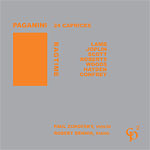
24 CAPRICES
LAMB, JOPLIN, SCOTT, ROBERTS, WOODS, HAYDEN, CONFREY
RAGTIME
PAUL ZUKOFSKY, violin
ROBERT DENNIS, piano

 |
PAGANINI 24 CAPRICES LAMB, JOPLIN, SCOTT, ROBERTS, WOODS, HAYDEN, CONFREY RAGTIME PAUL ZUKOFSKY, violin ROBERT DENNIS, piano |
 |
|
With this re-release of my recordings of Ragtime and Paganini Caprices, (originally made on the Vanguard label—my deep thanks to Greg Barbero and Artemis Classics), two fundamental advantages accrue. First—I am at last able to present the complete original repeat scheme of the Caprices, which scheme had to be altered in the original 2-LP release. My insistence upon the original repeat scheme is due to the observation that Paganini varies his use of repeats. Had he consistently repeated each and every section, the case could be made that the repeats were only a de-riguer convention, and omitting all repeats would nevertheless maintain all temporal-structural ratios. But the repeats VARY!; and to inconsistently omit repeats dramatically alters the overall pacing. Now the argument can be made that Paganini was not, and would not have been, concerned about that level of architecture; but we have no evidence that he was not, and when in doubt, if there is some additional structural information to be gleaned by maintaining large temporal ratios, it behooves us to do so. The second advantage lies in my being able to particularize an idea I have long held i.e. the pairing of the Paganini and Ragtime recordings, not as a matter of a cohabitation “de convenance”, but because these recordings are linked, as I would have never created the type of ragtime arrangements I did were it not for my time spent on, and my knowledge of, Paganini (as only one of many, many instances, I refer you to the “scordatura” in Grandfather’s Clock, with the G string retuned to F#). Having the opportunity to put both Pags and Rags in close proximity, the question arose “should one just slap-on the Rags after the Paganini”? I rejected this, for had I done so, not only would I have NOT clearly made the point I wanted to make, but it might have given the impression that the only reason for this seemingly disparate pairing was to fill time on a CD. So I decided to interweave the PRags, but on what basis? I tried various ideas (preserving key relationships across interstices; pairing similar violinistic aspects i.e. Rags and Caprices in octaves or thirds; etc) but I always arrived at the fairly conventional and overly-obvious, and found my mind and ideas dull. The idea of using I-Ching operations to determine the succession then became especially appealing, given that I could thereby pay simultaneous homage to three of my primary violinistic progenitors viz., my teacher Ivan Galamian (to whom the original Paganini LP release is dedicated); the influence (on my playing) of certain jazz violinists, such as Stephane Grappelli and Eddie South; and my work with John Cage. Given that the Paganini had an order authored by the composer, whereas the Ragtime had no particular order, my idea was to preserve the order of the former, while hurling in the latter as the I-Ching dictated. I was urged to not interleave, but instead to write about the cross-relations I had in mind; but to only write about this was a solution far too easy to ignore, in that few would ever bother to reorder the tracks; so I decided to force the issue by fixing one of a myriad of versions. This brought to the fore an aspect of “authentic performance practice”, in that it is highly unlikely that the Caprices were ever intended to be solely played nonstop, one directly after the other. Indeed, if you look at programs of the 19th century, you will find sacrosanct works (that “purists” today would never dream of splitting) constantly being interrupted by extraneous material shoved in, pell-mell, between movements. Therefore, not only am I not committing any particular sin against a fundamental approach to the Paganini, but rather I am honoring a forgotten tradition that, upon occasion, opens some rather interesting vistas. In addition to the restoration of the original repeats, and the interspersions, I have also changed (usually shortened) some of timings between the Caprices, so as to better reveal the shock of some of the quite surprising key changes. My notes to my edition of the Joplin Ragtime are to be found directly below, followed by the original Paganini liners (minus a small omission). (PZ May 2005) •Foreword to SCOTT JOPLIN RAGTIME Classics1These arrangements reopen the world of classic ragtime for violinists—reopen because they hint at a performance tradition which had to exist, but one at which we can only guess. We know that the violin was a strong part of Joplin’s sonic world, and it can not be a total coincidence that so many of the right hands of his rags “lie” perfectly for the instrument without any revision. There is nothing in these arrangements which could not have been played by any of the great jazz violinists. Simpler versions do exist, using the violin as part of a band. Unfortunately, while successfully countenancing a shopworn copy of the great gypsy violin tradition, we looked down our noses at our own native violin playing, both jazz and bluegrass, and exiled it from its rightful place in our violinistic heritage. These arrangements acknowledge my personal debt to that tradition, and my hope that it will have a greater influence on all violinists. (PZ, 1974) •The Paganini CapricesAt some point almost every violinist studies the 24 Caprices of Paganini and conceives of them as 24 pieces to be played as fast as possible. Indeed, the Caprices have been such a virtuosic yardstick that most musicians would find the “Composti e Dedicati Agli Artisti” of the first edition rather pretentious. Therefore, it is important to remember that the Caprices were musically important enough for Robert Schumann to transcribe a dozen of these Caprices for piano, as well as write piano accompaniments to all 24; for Liszt to transcribe five Caprices; and for such disparate composers as Brahms, Rachmaninov, Boris Blacher, Witold Lutoslawski and George Rochberg to be stimulated by the theme of the 24th Caprice. Those who know of my “specialization” in “new music” may be surprised that I periodically relearn “accepted” repertoire (primarily for synthesis of style)—and I had gradually come to the conclusion that the emphasis on speed alone did nothing to enhance the Caprices. I was fortunate in being able to obtain a photo-copy of the original mss. (courtesy G. Ricordi, Milano) as well as a Xerox of the first edition (Library of Congress) and I found sufficient discrepancies to warrant a rethinking of the Caprices. (Actually—I must have decided to rethink and then looked for moral support from the source). I wish to dedicate these discs, with great respect and affection, to my teacher Ivan Galamian. While I have not always followed the exact letter of his teaching I think I have followed the spirit, and I certainly would not now have been able to make certain decisions about these pieces were it not for his care when I first studied the Caprices with him more than 15 years ago.2 What follows are not analyses of the Caprices. They are the semi-private ramblings that led me to clarified decisions. Cap. #1 Andante #2 Moderato #3 Sostenuto / Presto–C/ #4 Maestoso #5 Introduction / Agitato-C – at last—a fast one! (though that’s my decision)—Agitato and the original bowing almost preclude “fast”—but I like spiccato. #6 Lento #7 Posato #8 Maestoso –C — imagine playing the orchestral part only of the opening Adagio of Mozart’s Violin Concerto in A (kv. 219). The #9 Allegretto #10 Vivace #11 Andante / Presto #12 Allegro–C — these accents should be above the dynamic range of the caprice—make them sff. #13 Allegro #14 Moderato #15 Posato #16 Presto #17 Sostenuto / Andante–C — Liszt says “più animato” at the octave section (not in Paganini). Not a bad idea. #18 Corrente / Allegro #19 Lento / Allegro assai–C – What is the correct stress? (syncopated or displaced). Maintain distinct dynamic levels. (Schumann also suggests this—op. 3, no. 5). Use harmonics for the slow passage in high register. #20 Allegretto #21 Amoroso – Presto–C –Don’t dawdle—achieve the Amoroso thru fingerings and not tempo. #22 Marcato #23 Posato #24 Tema-quasi Presto (PZ, 1969) Footnotes
The following is the missing paragraph from the original notes. It is no longer germane as all the repeats have been restored in the CP2 version. A few words are necessary concerning repetitions. When we timed the complete tape we discovered that it would be better to lop off some 20 minutes so that the Caprices could fit comfortably on 4 LP sides. There are 4 repeat schemes at work in the Caprices—(a) no repeats, (b) the first half only is repeated, (c) both halves are repeated, (d) standard “da Capo” (except for #23 for which see later). Obviously nothing could be done about (a), and I preferred not to disturb the form of (b) and (d). This left (c)—where we could remove the repeats without disturbing the internal balance of the Caprice though the overall variation of timing suffered somewhat. Consequently all the (c) Caprices (7, 8, 12 & 14) are without repeats. I implied earlier that #23 is an exception to the standard D.C. scheme. Within the group of D.C. Caprices there are 3 Caprices which have repeats within the D.C. (Nos. 13, 17 & 23). Both the mss. and the first edition specify da Capo “senza replica” for nos. 13 & 17 but not for no. 23. Even though this may simply be an oversight I have left all of the repeats for the da Capo of #23 because I find it an amusing formal trick, especially since it makes Caprice 23 so much out of proportion to its context.
Scott Joplin: (1868 – 1917) STOPTIME RAG (1910); THE EASY WINNERS (1901); MAGNETIC RAG (1914) James Scott: (1886 – 1938) CALLIOPE RAG (before 1914?) Luckey Roberts: (1887 – 1968) PORK AND BEANS (pub. 1913) Clarence Woods: (1888 – 1956) SLIPPERY ELM RAG (1912); SLEEPY HOLLOW RAG (1918) Scott Joplin with Scott Hayden: (1882 – 1915) FELICITY RAG (before 1905?) Zez Confrey: (1895 – 1971) GRANDFATHER’S CLOCK (1933) My transcriptions of Joplin Rags were published as Scott Joplin Ragtime Classics for Violin and Piano, E.B. Marks Music, 1974. All other transcriptions exist in mss only, and were collaborations with Robert Dennis. Original solo piano versions of all Ragtimes on this CD may be found in various Dover Publications editions (Classic Piano Rags, 1973; Ragtime Rarities, 1975); The Complete Works of Joplin, New York Public Library, 1982; Rudi Blesh and Harriet Janis, They All Played Ragtime, Random House, Inc., 1950; Zez Confrey Piano Solos, Ragtime, Novelty, and Jazz, Columbia Pictures Publications, 1984. Niccolò Paganini: (1782-1840) 24 CAPRICES (1805) Sources: photocopy of the original manuscript, from the archives of G. Ricordi & Co., Milan; photocopy of the first edition, from the Library of Congress, Washington, D.C. All recordings were made at the Vanguard Studios at 208 West 23rd Street, NYC. The Ragtime recordings were made during 1975. They were engineered by John Kilgore and originally released as “Classic Rags and other novelties” Vanguard SRV 350 SD. The Paganini recordings were made during 1969. They were originally released as: “Niccolò Paganini: The 24 Caprices” Vanguard VCS 10093/4. My thanks to Greg Barbero and Artemis Classics for making these, and the Bach Sonatas and Partitas, available. In 2005, the recordings were remixed and re-mastered (under the supervision of Paul Zukofsky) by Paul Zinman at SoundByte Productions, Inc., NYC. CP2 120-121 © 2005 Musical Observations, Inc. |
||||||||||||||||||||||||||||||||||||||||||||||||||||||||||||||||||||||||||||||||||||||||||||||||||||||||||||||||||||||||